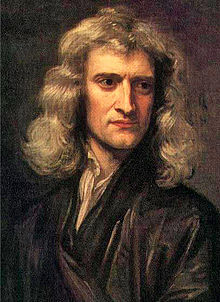General relativity (GR) is a theory of gravitation that was developed by Albert Einstein between 1907 and 1915, with contributions by many others after 1915. According to general relativity, the observed gravitational attraction between masses results from the warping of space and time by those masses.
Before the advent of general relativity, Newton's law of universal gravitation had been accepted for more than two hundred years as a valid description of the gravitational force between masses, even though Newton himself did not regard the theory as the final word on the nature of gravity. Within a century of Newton's formulation, careful astronomical observation revealed unexplainable variations between the theory and the observations. Under Newton's model, gravity was the result of an attractive force between massive objects. Although even Newton was bothered by the unknown nature of that force, the basic framework was extremely successful at describing motion.
Consequently, in 1907 (published 1908) he wrote an article on acceleration under special relativity.[2] In that article, he argued that free fall is really inertial motion, and that for a freefalling observer the rules of special relativity must apply. This argument is called the Equivalence principle. In the same article, Einstein also predicted the phenomenon of gravitational time dilation.
Gravitational time dilation is a form of time dilation, an actual difference of elapsed time between two events as measured by observers situated at varying distances from a gravitating mass. The stronger the gravitational potential (the closer the clock is to the source of gravitation), the slower time passes. Albert Einstein originally predicted this effect in his theory of relativity[1] and it has since been confirmed by tests of general relativity.
This has been demonstrated by noting that atomic clocks at differing altitudes (and thus different gravitational potential) will eventually show different times. The effects detected in such experiments are extremely small, with differences being measured in nanoseconds.

There are giants of science and I have mentioned some of them; Archimedes, Rutherford, Chadwick, Curie, and Einstein, but one of the greats is undoubtably Sir Isaac Newton. Newton not only developed a theory of gravity, he used a prism to split light into its individual colours, (Red, Orange, Yellow, Green, Blue, Indigo, Violet).
On the previous page I mentioned a particle (Tachyon) which is smaller than a photon (single particle of light) and travels faster than light. So doing it confuses space time and apparently defies the known laws of science. On the previous page I used the name 'Bakite'. Now I'm going to use the word derrived from the Greek word for bread, Artos, the Arton, to fit with the words electron, proton, neutron and photon.
Most physicists think that faster-than-light particles cannot exist because they are not consistent with the known laws of physics.[3][4] If such particles did exist, they could be used to build a tachyonic antitelephone and send signals faster than light, which (according to special relativity) would lead to violations of causality.[4] Potentially consistent theories that allow faster-than-light particles include those that break Lorentz invariance, the symmetry underlying special relativity, so that the speed of light is not a barrier.
The Arton, or theoretical particle which travels faster than the speed of light, also travels in straight lines as photons do. Einstein corrected Newtons calculations regarding the "precession of the perihedron" and "gravitational lensing".
This is explained in more detail later in the book. For now, in summary, let us just ask why the sky appears blue to us? It is because light of that wavelength, (the one which appears blue to our eyes, about 475 nm). Maybe, we would assume that only a portion of the sky should appear blue, and a portion red, or violet perhaps. However it is blue because light is bent and scattered as it enters the atmosphere.
Now imagine that a particle leaves the earth, and travels directly toward the largest mass in the solar system, the sun. If it happens to pass either the planet venus, or mercury on its way, which is going to happen only once in a Venusian (243 days) or Mercurial (88 earth days) year.
Instead of a particle travelling to the mass of the sun, imagine that it "falls" downward inside a proton or a neutron. On the previous page I described briefly five levels that it could be falling until it reaches the centre of mass. In theory there is no reason why this should be five levels, or could not be 21 levels, or an infinite number, but I have reasons for five.
Somewhere between the outside level, (the first) and the third level, (ie between the 2nd and 3rd levels which are shells of energy, or clouds of energy like electron clouds would be, but on a smaller scale, the particles take a distinct turn, and head off toward a mass which is not at the centre. If the centre is at 12 oclock, then they could be heading for 2 oclock, for example. more
The visible blue light has a wavelength of about 475 nm. Because the blue wavelengths are shorter in the visible spectrum, they are scattered more efficiently by the molecules in the atmosphere. This causes the sky to appear blue.